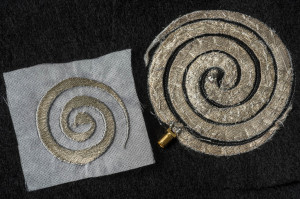
You may love your fitbit, but one day your clothes could monitor your fitness levels or even boost your smart phone reception. Developed by researchers at Ohio State University, a new technique using ultrathin electronic thread to embroider circuits into fabric could make this possible.
Computer World reports that the researchers have found a way to embroider circuits into fabric with enough precision to integrate electronic components, such as sensors and memory devices into clothing. Measuring just 0.1 mm in diameter, the thread is made of copper and silver filaments.
Ultimately, these e-textiles could be used to create shirts that act as antennas, bandages that tell your doctor how well a wound is healing, or to make caps that sense activity in the brain.
“Now, for the first time, we’ve achieved the accuracy of printed metal circuit boards, so our new goal is to take advantage of the precision to incorporate receivers and other electronic components,” said John Volakis, director of Ohio State’s ElectroScience Laboratory.
The researchers used a standard tabletop sewing machine to embroider the e-textiles. The shape of the embroidery determines the operating frequency of the antenna or circuit.
One broadband antenna, for example, consists of more than half a dozen interlocking geometric shapes, each a little bigger than a fingernail, that form an intricate circle a few inches across. Each piece of the circle transmits energy at a different frequency, so together they cover a broad spectrum. That embroidery takes about 15 minutes to create and uses about 10 feet of the specialized thread, for a material cost of roughly 30 cents per antenna.
In tests, an embroidered spiral antenna measuring about six inches across transmitted signals at frequencies of 1 to 5 GHz with near-perfect efficiency, the researchers said, making it suitable for broadband Internet and cellular communication.
A paper describing the researchers’ findings was published recently in the journal IEEE Antennas and Wireless Propagation Letters. Ohio State plans to license the technology for further development.
 TEXTILES.ORG
TEXTILES.ORG


